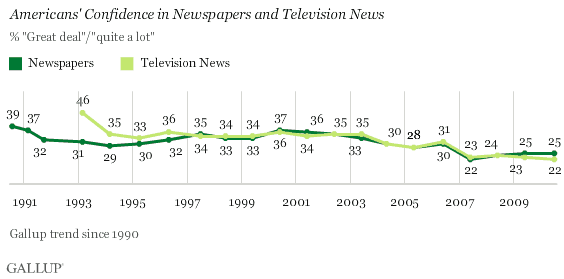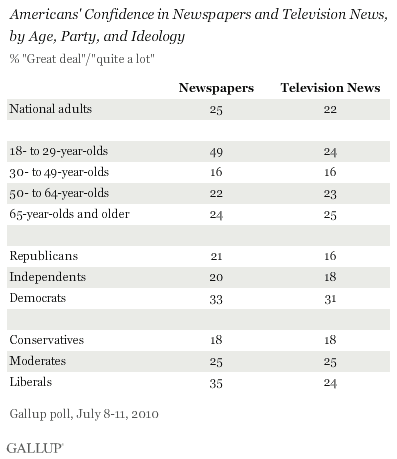WASHINGTON, D.C. -- Americans continue to express near-record-low confidence in newspapers and television news -- with no more than 25% of Americans saying they have a "great deal" or "quite a lot" of confidence in either. These views have hardly budged since falling more than 10 percentage points from 2003-2007.

The findings are from Gallup's annual Confidence in Institutions survey, which found the military faring best and Congress faring worst of 16 institutions tested. Americans' confidence in newspapers and television news is on par with Americans' lackluster confidence in banks and slightly better than their dismal rating of Health Management Organizations and big business.
The decline in trust since 2003 is also evident in a 2009 Gallup poll that asked about confidence and trust in the "mass media" more broadly. While perceptions of media bias present a viable hypothesis, Americans have not over the same period grown any more likely to say the news media are too conservative or too liberal.
No matter the cause, it is clear the media as a whole are not gaining new fans as they struggle to serve and compete with growing demand for online news, social media, and mobile platforms. The Pew Project for Excellence in Journalism's annual report on the State of the News Media, released in March, found for a third straight year, only digital and cable news sources growing in popularity, while network news, local news, and newspaper audiences shrink. These findings align with a similar 2008 Gallup poll that found cable and Internet news sources growing in popularity while all others held steady or declined.
While it is unclear how much respondents factored in the online and cable offshoots of "newspapers" and "television news" when assessing their confidence in these institutions, their responses do not provide much encouragement for the media more broadly. Confidence is hard to find, even among Democrats and liberals, who have historically been the most trusting of the news media. While 18- to 29-year-olds express more trust in newspapers than most older Americans, Gallup polling has found they read national newspapers the least. Younger Americans also expressed more confidence than older Americans in several other institutions tested, including Congress, the medical system, and the criminal justice system, suggesting younger Americans are more confident in institutions in general.

Implications
With nearly all news organizations struggling to keep up with the up-to-the-minute news cycle and to remain profitable in the process, Americans' low trust in newspapers and television news presents a critical barrier to success. The Pew report asserts that 80% of new media links are to legacy newspapers and broadcast networks, making clear that traditional news sources remain the backbone of the media. But so long as roughly three in four Americans remain distrustful, it will be difficult to attract the large and loyal audiences necessary to boost revenues.
Results for this Gallup poll are based on telephone interviews conducted July 8-11, 2010, with a random sample of 1,020 adults, aged 18 and older, living in the continental U.S., selected using random-digit-dial sampling.
For results based on the total sample of national adults, one can say with 95% confidence that the maximum margin of sampling error is ±4 percentage points.
Interviews are conducted with respondents on landline telephones (for respondents with a landline telephone) and cellular phones (for respondents who are cell phone-only). Each sample includes a minimum quota of 150 cell phone-only respondents and 850 landline respondents, with additional minimum quotas among landline respondents for gender within region. Landline respondents are chosen at random within each household on the basis of which member had the most recent birthday.
Samples are weighted by gender, age, race, education, region, and phone lines. Demographic weighting targets are based on the March 2009 Current Population Survey figures for the aged 18 and older non-institutionalized population living in continental U.S. telephone households. All reported margins of sampling error include the computed design effects for weighting and sample design.
In addition to sampling error, question wording and practical difficulties in conducting surveys can introduce error or bias into the findings of public opinion polls.
For more details on Gallup's polling methodology, visit https://www.gallup.com/.
